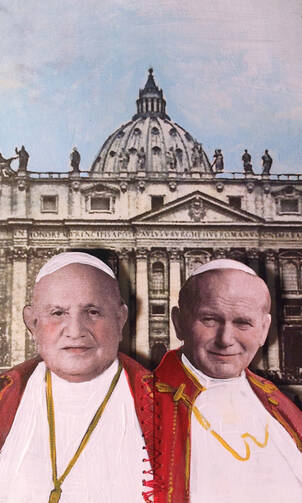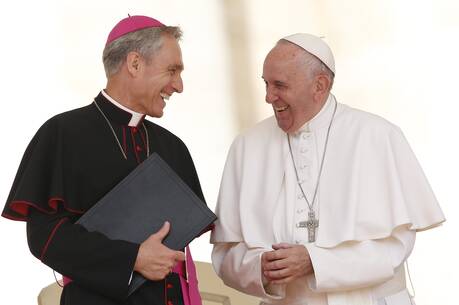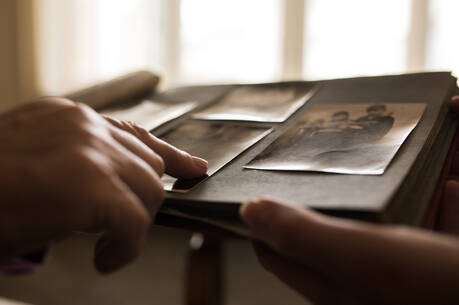I was a seminarian in Rome when Angelo Giuseppe Roncalli was elected Pope John XXIII. More than five decades later, I found myself in Rome once more, on April 27, at the canonization ceremony that celebrated Pope John’s holy life, as well as that of Pope John Paul II. I was one of 800 priests distributing Communion that day, and the experience offered me the chance to reflect on what these great men have meant to the church.
I participated in the visit by Pope John XXIII to our seminary, the North American College, on Oct. 11, 1959. Although we listened closely to the pope’s homily in English—he had been coached by his Irish priest secretary—we understood nothing of what he was trying to say.
A few days later, my bishop was given an audience with Pope John and invited me to accompany him. The audience was conducted in French, one of the two languages Pope John spoke fluently, and his characteristic informality shone through. At the end of our audience, instead of bowing politely, the pope himself walked us out.
As we walked to the door, I was anxious to say something to the pope and so, at that last moment, wanting to express appreciation for the gesture he made to us at the seminary by preaching in English, I said, “Sainteté, votre parole à nous en anglais était...” (“Your holiness, your words to us in English were…”) and searching for a word that would say how deeply impressed we were by his attempt, I chose magnifique. Pope John then took my hands into his and said in French, “Let me tell you something St. Philip Neri used to say. When people say something negative about you they may be speaking the truth, but if they say something positive, they could be making fun of you.” He knew he had failed in his attempt at speaking in English and then went on to comment how difficult a language it is to master.
Years later I became rector of the North American College, and I was present for the election of Karol Jozef Wojtyla, who began his pontificate as Pope John Paul II on Oct. 22, 1978. He later accepted my invitation to come to the North American College, a visit that took place on Feb. 22, 1980. The visit lasted four hours. It began by my asking him to plant a California sequoia on our grounds, as it seemed a more fitting tribute than a marble plaque for this young and athletic pope. When he departed at 10 p.m. he turned and said to me, “Planting that tree was a good idea!”
After the pope celebrated Mass and individually greeted every single priest, seminarian and employee of the college, we sat down to dinner. It was Lent, and the Vatican had instructed us to serve soup and bread. My conversation with the pope consisted mostly of him asking me questions. I realized how reserved he was in such situations, yet he also made me feel comfortable enough to finally ask him a question in return. To a much lesser degree than the pope, I was trying to balance my scholarly interests with administrative duties, and so I asked him how he was managing to accomplish this himself. He replied, “I take no appointments until 11 o’clock in the morning. This allows me to devote the early morning hours to reading and writing, although at this point it’s mostly writing.”
This Is The Day
I did not sleep well the night before the canonization Mass. There were reports that more than a million people would be converging, with busloads arriving daily from Poland and Bergamo in northern Italy. No tickets were being issued; people were sleeping in the streets to get a good spot. The weather forecast included an 80 percent chance of rain during the outdoor ceremony, and I worried about getting from the North American College to St. Peter’s.
I decided to leave the seminary through a rarely used back gate and walk down a blocked street toward the basilica. Friendly police created space to penetrate the crowds, and I arrived safely in the Blessed Sacrament chapel of St. Peter’s—the location designated as the meeting place for the extraordinary ministers of the Eucharist. Ominous black clouds supplied a few rain drops, but as the morning unfolded the sun appeared.
Those quiet moments in the closed, darkened basilica were the most precious for me that day. A few cardinals were praying at the nearby tombs of the two popes, and I was able to savor this special moment.
Finally, our group moved to the main church. Pope Francis chose to make his entrance behind the altar from the front doors of St. Peter’s. The crowds were instructed to make no applause, not even to wave their banners; they were to join in the chanting of the Litany of the Saints and so enter into a prayerful atmosphere for the Mass.
In his homily Pope Francis spoke with eloquent simplicity about the heroic virtues of the two new saints. John XXIII transformed the papacy into a position of world leadership and summoned the Second Vatican Council. John Paul II participated in the fall of Communism and his papacy was the second longest in history. Pope Francis described them respectively as one who was open and docile to the inspiration of the Holy Spirit and “the pope who was devoted to the life of the family.” He said: “They lived through the tragic events of the 20th century but were not overwhelmed by them. For them, God was more powerful, their faith was stronger—their faith—and Jesus Christ, the redeemer of man.”
Pope Francis clearly saw the appropriateness of canonizing the two popes together, for John Paul II’s papacy would have been impossible without the accomplishments of John XXIII. For over a century the popes were self-proclaimed “prisoners of the Vatican,” protesting Italy’s confiscation of the papal states. Pope John was the first to venture outside the Vatican, making pilgrimages to Assisi and Loretto. This led the way for John Paul to travel the world. John convened Vatican II, which taught that all Christians, lay, religious and clergy, are called to one and the same perfection of holiness. John Paul underlined the point by canonizing more saints than all previous popes combined. John’s social teaching in his landmark encyclicals, “Mater et Magistra” and “Pacem in Terris” were built upon by John Paul as he sought to make a greater connection between the church and the world.
Vatican II called for more collegiality and consultation in church governance. Now Pope Francis has taken this to heart. With his rapport with those on the fringes of society, Francis has adopted the pastoral style of Pope John. Long before Pope Francis did so, Pope John visited people in prison and shocked his entourage by saying, “I feel comfortable with you. Some of my relatives have been in prison!”
On the day these men were canonized, I pushed myself to the limits, bringing Holy Communion to people in the square before being directed to proceed down the Via della Conciliazione toward the Tiber to still more of the crowd. I was accompanied by a young priest professor from the University of Lublin, where Pope John Paul had taught. He came to Rome from Poland over the Alps on his motorcycle. Another of the priests near me was from the diocese of Sacramento. His trouser pockets were so filled with religious medals he intended to distribute at home that he found it difficult to climb the stairs to bring Communion to the people on the bleachers on top of the Bernini colonnade.
I traveled to Rome filled with memories of joyous encounters, and hope for what the raising up of Pope John XXIII and Pope John Paul II means for the church. At the audience with Pope Francis the following Wednesday, I recognized the beginning of a new phase with a new pope and returned home renewed in my joy, assured of my hope.








